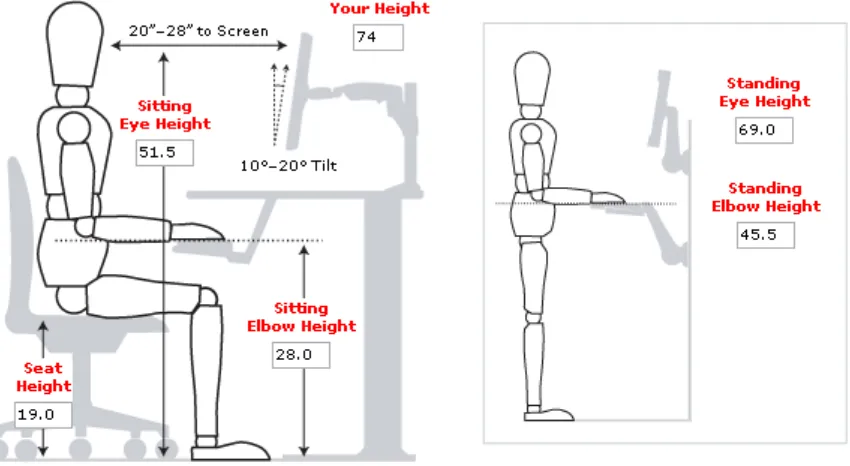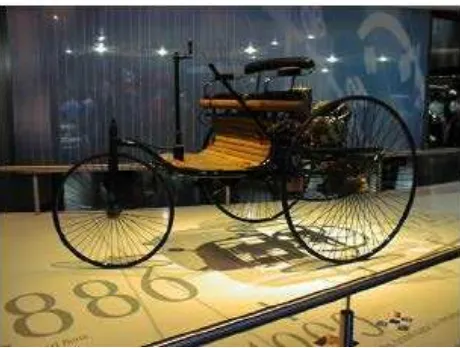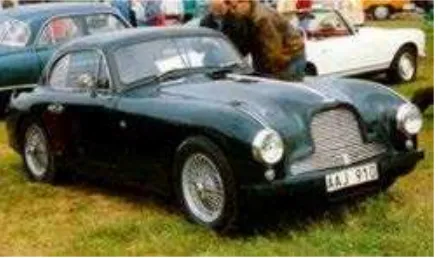DEVELOPMENT OF ERGONOMICS PASSENGER CAR DRIVER SEAT CONCEPT DESIGN
MOHD SYAFIQ BIN MAT SAMUJI
This technical report is submitted in accordance with the requirements of the Bachelor of Mechanical Engineering (Automotive)
Faculty of Mechanical Engineering Universiti Teknikal Malaysia Melaka
i
CONFIRMATION
“I admit that have read this work and in my opinion this work was adequate from scope aspect and quality to award in purpose Bachelor of Mechanical Engineering
(Automotive)”
Signature :……… 1st Supervisor’s name:……… Date :………
ii
DECLARATION
“I hereby, declare this thesis entitled
Development of Ergonomics Passenger Car Driver Seat Concept Design is the results of my own research except as cited in the reference”
Signature : ………
Author Name : ………
Date : ………
iii
To My Beloved Mother, Pn Hajah Noraini Mansor
and My Beloved Father. Tn Haji Mat Samuji Sakidi
iv
ACKNOWLEDGEMENT
In the name of Allah, the Most Gracious and the Most Merciful, It is with the
deepest senses gratitude of the almighty that gives strength and ability to complete
this project and technical report.
First of the foremost, I would like to dedicate my special thanks to my project
supervisor, En Razali bin Mohd Tihth, lecturer of Universiti Teknikal Malaysia
Melaka to allow do this project under his supervision. Thanks for all the valuable
information and ideas how to perform this project.
Last, but certainly not least, thanks to the continuous encouragement and
support of my family and all my friends in Universiti Teknikal Malaysia Melaka and
the others who somehow that invite whether directly or indirectly in the completion
v
ABSTRAK
vi
ABSTRACT
vii
TABLE OF CONTENT
CHAPTER TITLE PAGES
CONFIRMATION i
DECLARATION ii
DEDICATION iii
ACKNOWLEDGEMENT iv
ABSTRAK v
ABSTRACT vi
TABLE OF CONTENT vii
LIST OF TABLE xi
LIST OF FIGURE xii
LIST OF APPENDIX xv
CHAPTER 1 INTRODUCTION 1
1.1 OBJECTIVE OF THE PROJECT 1
1.2 SCOPE OF THE PROJECT 2
1.3 PROBLEM BACKGROUND 2
1.4 EXPECTED RESULT 3
CHAPTER 2 LITERATURE REVIEW 4
2.1 ERGONOMICS 4
2.1.1 ERGONOMICS ASPECTS 5
2.1.2 HISTORY OF ERGONOMICS 5
2.2 CAR SEAT 7
2.2.1 EVOLUTION OF CAR SEAT 7
viii
2.2.3 EXISTING DESIGN OF CAR SEAT 9
2.3 HUMAN FACTOR IN DESIGNING CAR 12
SEAT
2.4 BODY BACK PAIN 13
2.4.1 SOURCES OF BACK PAIN 14
2.5 CAD (COMPUTER AIDED DESIGN) 14
2.6 RELATED STANDARDS 16
2.6.1 FEDERAL MOTOR VEHICLE SAFETY 16 STANDARD (FMVSS) STANDARD
NO. 207; SEATING SYSTEM
2.6.2 FEDERAL MOTOR VEHICLE SAFETY 17 STANDARD (FMVSS) STANDARD
NO. 202; HEAD RESTRAINTS
2.6.3 SOCIETY OF AUTOMOTIVE 18
ENGINEERS (SAE) STANDARDS
CHAPTER 3 METHODOLOGY 19
3.1 PROCESS PLANNING 19
3.2 EXPLANATION ON EACH PROCESS 21
PLANNING
3.2.1 PROBLEM STATEMENT IDENTIFICATION 21
3.2.2 LITERATURE REVIEW 22
3.2.3 IDENTIFICATION ON RELATED INPUT 22 DATA FOR ERGONOMICS PASSENGER
CAR SEAT
3.2.4 SET UP SURVEY FORM TO COLLECT REAL 22 TIME DATA
3.2.5 GATHER REQUIRED DATA FROM THE 23 RESPONDENTS
3.2.6 ANALYSIS ON RESULTS OF SURVEY 23 3.2.7 CONCEPTUAL DESIGN DEVELOPMENT 23 3.2.8 CAD DRAWING OF THE CONCEPTUAL 23
DESIGN
ix
3.2.10 DISCUSSIONS AND CONCLUSIONS 24
CHAPTER 4 RESULTS 25
4.1 THE ANTHROPOMETRIC DATA FOR 25
50TH PERCENTILE OF ASIAN POPULATION
4.2 THE ERGONOMIC POSITION 26
4.3 ANALYSIS OF THE SURVEY FORM 27
4.4 CONCEPT DESIGN DEVELOPMENT 36
4.4.1 DESIGN ITERATION 1 37
4.4.2 DESIGN ITERATION 2 38
4.4.3 DESIGN ITERATION 3 39
4.5 COMPARATIVE DESIGN ANALYSIS 40
4.6 THE CAR SEAT MECHANISM 41
4.6.1 LUMBAR COMPONENT 41
4.6.2 BOLSTER SUPPORT SYSTEM 42
4.6.3 PAN LENGTH 42
4.6.4 PAN HEIGHT ADJUSTMENT 42
4.6.5 HEAD RESTRAINT 43
4.6.6 MATERIAL SELECTION 43
4.7 CONCEPT DESIGNS IN CAD SOFTWARE 43
4.7.1 SPECIFICATIONS OF THE DESIGN 45
4.8 ANALYSIS 46
4.8.1 RULA ANALYSIS 46
4.8.2 CASE STUDIES 48
4.8.2.1 TOYOTA RUSH 49
x
CHAPTER 5 DISCUSSION 52
CHAPTER 6 CONCLUSION AND RECOMMENDATION 54
6.1 CONCLUSION 54
6.2 RECOMMENDATION 55
REFERENCES 56
xi
LIST OF TABLES
NO. TITLE PAGES
2.1 Causes of seating discomfort (Source: T.C Fai et al, 2007) 9
2.2 Categories of the action – RULA (Sá, 2006) 15
4.1 Dimension of 50th Percentile of Asian Population 26 (Catia V5R15 database)
4.2 QFD comparing three types of design iteration 40
4.3 Specification of the driver car seat design 45
xii
LIST OF FIGURES
NO. TITLE PAGES
2.1 Ergonomics factor when designing workplace (McLeod, 2007) 5
2.2 1885 Benz Motorwagen with bench seat (Logitech) 7
2.3 Ford Model A 1930 (Wikipedia c) 8
2.4 Aston Martin DB2 Coupé 1952 (Wikipedia d) 8
2.5 Seat Nomenclature (D. M. Severy, 1976) 10
2.6 Early Alfa Romeo seat design (World Upholstery) 11
2.7 H1, H2 and Kerb Height (Source: McIlwraith) 12
2.8 The lower roof line has forced seat to be angled back and 13 lowered (McIlwraith, An Analysis of the Driving Position
in the Modern Car, 1993)
2.9 SAE Human Accommodation and Design Devices and Driver 18 Vision Standards (Reed, 2007)
3.1 Process planning 20
xiii
4.2 The Ergonomics driving position (McIlwraith, An Analysis 27 of the Driving Position in the Modern Car, 1993)
4.3 Graph of real time data of percentage sitting in the same 28 position for a long period while driving lead to pain of the body
4.4 Graph of real time data of percentage that the vibration that 29 occur from road surface (road input) resulted to pain of the body
4.5 Graph of real time data of percentage of the part of the body 30 that suffers the most pain while driving
4.6 Graph of real time data of percentage of agreed car seat comfort 31 level (National car)
4.7 Graph of real time data of percentage of agreed car seat comfort 31 level (Japanese car)
4.8 Graph of real time data of percentage of agreed car seat comfort 32 level (Continental car)
4.9 First type of driving position (McIlwraith, An Analysis of the Driving 33 Position in the Modern Car, 1993)
4.10 Second type of driving position (McIlwraith, An Analysis of the Driving 33 Position in the Modern Car, 1993)
4.11 Graph of real time data of percentage of preferred driving position 34
xiv
4.13 Graph of real time data of percentage of preferred accessories 36 to be attached to the car seat
4.14 Design iteration 1 37
4.15 Design iteration 2 38
4.16 Design iteration 3 39
4.17 Lumbar component 41
4.18 Pan contour 42
4.19 Isometric view of the concept design 44
4.20 Isometric view of the concept design with 50th-percentile adult of 44 Asian population mannequin
4.21 Side view of the concept design with 50th-percentile adult of 45 Asian population mannequin
4.22 RULA analysis of the ergonomics position 47
4.23 Vision of the mannequin in Toyota Rush 49
4.24 Side view of the mannequin in ergonomics position in Toyota Rush 49
4.25 Vision of the mannequin in Toyota Vios 50
xv
LIST OF APPENDIX
NO TITLE PAGES
A The survey form that has been conducted (English version) 65
B The survey form that has been conducted (Malay version) 67
C Gantt Chart for semester 1 69
D Gantt Chart for semester 2 70
E Survey form of real time data input 71
F The illustration of segment proportions for East Asian male adults 67 in standing posture
G The illustration of segment proportions for East Asian male adults 68 in sitting posture
1
CHAPTER 1
INTRODUCTION
The basic feature in the urban life is the movement of large volume of people between residential area and places of work. People tends to posses their own car due to several factor such as it is available when required, the car takes the people from point A to point B besides ensuring the privacy and comfort. One of the problems that occur in driving is the bad design of the seat normally happened in budget car which results on less comfort to the driver.
1.1 OBJECTIVE OF THE PROJECT
a) To come out with the ergonomics passenger car seat concept design in form of 3D solid modeling data.
b) To understand the human characteristics and its ergonomics position during sitting in the passenger car.
2
1.2 SCOPE OF THE PROJECT
a) Literature on
• Related standards and requirements, including existing designs, and patents.
• Human characteristics when sitting on the car seat in term of ergonomics and safety.
b) Design
• To established the engineering design specification for ergonomics car driver seat
• To develops concept design base on finding.
• To select the final concept design, followed by solid modeling data development using the CAD system.
c) Analysis
• To do evaluation and analysis of concept design that has been developed.
• To do a validation work virtually in term of visibility
• Conclusion and design recommendation (for further development).
1.3 PROBLEM BACKGROUND
3
the ergonomics position and ensure all these positions to be put on the right place and right time.
1.4 EXPECTED RESULT
4
CHAPTER 2
LITERATURE REVIEW
The literature review is to state the previous research findings, the discussion on the related standards and requirements of the car seat including the existing design and understand the importance of the input data needed to be considered in the design process.
2.1 ERGONOMICS
Ergonomics is the scientific discipline concerned with designing according to the human needs, and the profession that applies theory, principles, data and methods to design in order to optimize human well-being and overall system performance which is also called human engineering and human factors (Wikipedia a). When ergonomics factor is taken into account, the human capabilities and limitations of the certain design is being considered.
5
2.1.1 ERGONOMICS ASPECTS
[image:21.595.125.550.181.414.2]There are five main points of ergonomics aspects. The aspects are safety, comfort, ease of use, productivity or performance, and aesthetics (Wikipedia a).
Figure 2.1: Ergonomics factor when designing workplace (McLeod, 2007)
2.1.2 HISTORY OF ERGONOMICS
Ergonomics has been considered since the culture of Ancient Greece. (Marmaras. N, 1999) The ergonomic terms is derived from the Greek words ergon [work] and nomos [natural laws] and first entered the modern lexicon when Wojciech Jastrzębowski used the word in his 1857 article Rys ergonomji czyli nauki
o pracy, opartej na prawdach poczerpniętych z Nauki Przyrody (Wikipedia a)
Wojciech Jastrzebowski created the word ergonomics in 1857 in a philosophical narrative, "based upon the truths drawn from the Science of Nature" (Ergoweb Inc).
6
fitting the machine to the size of the soldier and logical/understandable control buttons evolved.
After World War II, the focus of concern expanded to include worker safety as well as productivity. Research began in a variety of areas such as (Ergoweb Inc):
i. Muscle force required to perform manual tasks. ii. Compressive low back disk force when lifting.
iii. Cardiovascular response when performing heavy labor.
iv. Perceived maximum load that can be carried pushed or pulled.
In the early 1900's, the production of industry was still largely dependent on human power and ergonomic concepts were developing to improve worker productivity. Scientific Management which is a method that improved worker efficiency by improving the job process became popular.
Frederick W. Taylor was a pioneer of this approach and evaluated jobs to determine the "One Best Way" they could be performed. At Bethlehem Steel, Taylor dramatically increased worker production and wages in a shoveling task by matching the shovel with the type of material that was being moved (ashes, coal or ore) (Ergoweb Inc).
7
2.2 CAR SEAT
The car seat purpose is to support the buttocks, the thighs, the back which include the upper and lower back and the head support. Three main parts that the existing car seat designs posses are the seat back (squab), the seat base (cushion) and the headrest (Bryan, 2008). Most of the car seat nowadays has all of these parts.
2.2.1 EVOLUTION OF CAR SEAT
Car seat design has been improved gradually. In the earlier days of car invention, the car seat is not as comfortable as it may have nowadays. The design is based on the adaptation of the horse-drawn carriage. The evolution of car seat started with bench seat in the earlier days to bucket seat in the present days.
[image:23.595.214.444.402.576.2]
The figure above shows the Karl Benz 1885 Motorwagen that had a hard, wood bench seat that stretch from driver to passenger and a thin, curved beam that hit the upper back providing minimal support (Logitech). The main point of this seat is that it is fixed in only one position. Even though there are many alterations being made such as padded upholstery and additional substantial back support, the fixed position leads to many problems, as different people has different shape of lumbar.
8
Next, for the Ford Model T which is the first automobile built by mass production by Ford Britain during 1914 (Wikipedia b). The seat has not changed much. The car seat is the same fixed position with padded upholstery.
[image:24.595.210.429.257.406.2]The changes of the car seat design happen tremendously after that year. The Ford Model A for the year 1930 seat had been revolutionized with added adjustability to the front seats with a ‘worm gear controller’ which is the metal rod that ran beneath the front seat to move the seat forward and rearward
Figure 2.3: Ford Model A 1930 (Wikipedia c)
In the 50’s and 60’s with the introduction of the sport and compact cars such as the Aston Martin DB2, the nowadays concept bucket seat has been made into mass production.
[image:24.595.211.430.534.663.2]

